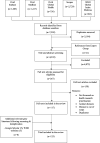Research prioritisation in preparedness for and response to outbreaks of high-consequence pathogens: a scoping review
- PMID: 40059172
- PMCID: PMC11892158
- DOI: 10.1186/s12916-025-03973-8
Research prioritisation in preparedness for and response to outbreaks of high-consequence pathogens: a scoping review
Abstract
Background: Priority setting for research on epidemic/pandemic-prone pathogens is essential for the allocation of limited resources to optimise impact. It involves the identification of gaps in knowledge crucial to effective preparedness and response to outbreaks. This review maps priority-setting exercises, reviews their approaches to research prioritisation and describes associated monitoring and evaluation processes for research priorities on high-consequence pathogens.
Methods: Using search terms associated with high-consequence pathogens, as defined by the WHO (2020), EMERGE (2019), European CDC (2022) and the Association of Southeast Asian Nations (2021), and research prioritisation, we searched WHO Global Index Medicus; Ovid Medline; Ovid Embase; Ovid Global Health; and Scopus. Grey literature sources were Google Scholar and the WHO websites, complemented by recommendations from stakeholder consultation. Two independent reviewers screened abstracts and full-texts including documents describing research prioritisation activities. Results were analysed using descriptive statistics and narrative synthesis.
Results: We identified 125 publications presenting priority setting activities on 17 high-consequence pathogens published between 1975 and 2022. Most (62%) were related to SARS-CoV-2, 5.6% to Ebola virus and 5% to Zika virus. Three different broad approaches to setting priorities were identified, most (53%) involved external consultations with experts. Few (6%) indicated plans to monitor progress against set priorities.
Conclusions: Our results highlight the diversity in research prioritisation practice in the context of high-consequence pathogens and a limited application of the existing standards in health research prioritisation. An increased uptake of these standards and harmonisation of practice may improve quality and confidence and ultimately improve alignment of funded research with the resulting priorities.
Keywords: High-consequence pathogens; Outbreaks; Preparedness; Research prioritisation; Response.
© 2025. The Author(s).
Conflict of interest statement
Declarations. Ethics approval and consent to participate: Not applicable. Consent for publication: Not applicable. Competing interests: The authors declare no competing interests.
Figures





Similar articles
-
Beyond the black stump: rapid reviews of health research issues affecting regional, rural and remote Australia.Med J Aust. 2020 Dec;213 Suppl 11:S3-S32.e1. doi: 10.5694/mja2.50881. Med J Aust. 2020. PMID: 33314144
-
Strategies to foster community engagement for epidemic and pandemic preparedness and response in sub-Saharan Africa: a scoping review protocol.BMJ Open. 2024 Jun 5;14(6):e082757. doi: 10.1136/bmjopen-2023-082757. BMJ Open. 2024. PMID: 38839384 Free PMC article.
-
A systematic review to identify research priority setting in Black and minority ethnic health and evaluate their processes.PLoS One. 2021 May 28;16(5):e0251685. doi: 10.1371/journal.pone.0251685. eCollection 2021. PLoS One. 2021. PMID: 34048459 Free PMC article.
-
Future support on evidence-informed priority setting and situational analysis of the potential role of Health Technology Assessment in Africa to support future pandemic preparedness and response: protocol for a scoping review.Syst Rev. 2024 Jul 26;13(1):198. doi: 10.1186/s13643-024-02610-4. Syst Rev. 2024. PMID: 39061088 Free PMC article.
-
Prioritisation processes for programme implementation and evaluation in public health: A scoping review.Front Public Health. 2023 Mar 27;11:1106163. doi: 10.3389/fpubh.2023.1106163. eCollection 2023. Front Public Health. 2023. PMID: 37050947 Free PMC article.
References
-
- Millum J. Background paper: the ethics of health research priority setting. Global Forum on Bioethics in Research (GFBR); 2023. https://www.gfbr.global/wp-content/uploads/2023/04/GFBR-2023-background-.... Accessed 3 May 2024.
-
- World Health Organisation. A coordinated global research roadmap: 2019 novel coronavirus. 2020. https://www.who.int/publications/m/item/a-coordinated-global-research-ro.... Accessed 7 Sep 2022.
Publication types
MeSH terms
Grants and funding
LinkOut - more resources
Full Text Sources
Miscellaneous

